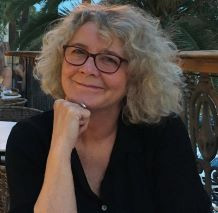Maureen Carroll
Chair in Roman Archaeology
Visit Maureen Carroll 's profile on the York Research Database to:
- See a full list of publications
- Browse activities and projects
- Explore connections, collaborators, related work and more
Profile
Biography
Maureen trained as a Classical Archaeologist in North America and Europe. She obtained a BA Honours in Classical Studies at Brock University (Canada), an MA in Classical Archaeology at Indiana University (U.S.A.), and a PhD in Classical Archaeology at Indiana University and the Freie Universität in Berlin. After over a decade of working for the state archaeological services in Germany and teaching at the University of Cologne, Maureen joined the Department of Archaeology at the University of Sheffield where, in 2013, she was promoted to Professor of Roman Archaeology. She joined the Department of Archaeology at York as Chair in Roman Archaeology in September 2020.
In 2019, the Archaeological Institute of America appointed Maureen as the distinguished Charles Eliot Norton Memorial Lecturer, inviting her to conduct a lecture tour of seven universities in Canada. She has been visiting professor at the Universität Basel and the Université de Fribourg in Switzerland, the Humboldt Universität in Berlin, and at McMaster University and the University of Calgary in Canada.
Maureen is a Roman archaeologist whose key research interests are Roman burial practices, funerary commemoration, and Roman childhood and family studies. She headed up the British team participating in a large EU-funded multinational project (DressID) on Roman textiles and clothing, her focus being on dress and identity in funerary portraits on the Rhine and Danube frontiers. A further area of interest is the topic of Roman garden archaeology, on which she has published extensively.
She has directed excavations in Germany, Italy, Tunisia, and Britain. Her fieldwork project on a Roman imperial estate in Puglia in south-east Italy, funded by the British Academy/Leverhulme Trust, the Roman Society, the Social Sciences and Humanities Research Council of Canada (SSHRC), and the Rust Family Foundation, was published in spring 2022.
She currently is conducting a project, funded by the Leverhulme Trust, on Dress and Identity in Early Roman Southwest Italy. This project investigates the interconnected relationship between dress behaviour, ethnic identity, and social status among independent population groups in regions south of Rome in the 4th century B.C., as revealed in painted funerary portraits in the tombs of indigenous elites in Campania and Lucania.
Maureen is also engaged in research on Roman gypsum burials. The custom of pouring liquid gypsum over the dead in stone or lead coffins before their deposition in the ground is particularly observable in and around York. The now hardened gypsum preserves the original position and contours of the dead as well as the imprint of their shrouds and clothing. The project investigates why and for whom this ritual was chosen, and it uses digital technology to transform the negatives in the gypsum casings into detailed positive images.
Departmental roles
Director of Studies, MA in Roman Archaeology (2020-)
Research
Overview
Maureen published her research on Roman childhood in 2018 in the volume Infancy and Earliest Childhood in the Roman World. ‘A Fragment of Time’ (Oxford University Press). Maureen’s work integrated archaeological and skeletal evidence, material culture, and iconography with social and cultural history, dispelling the long-held notion that very young children in the Roman world were marginal beings without any social significance whose lives were treated with indifference in an age of high infant mortality. This research was supported by the Balsdon Fellowship at the British School at Rome and a Leverhulme Research Fellowship. She also has researched the role of supplication and votive dedications in promoting maternal health and family continuity, and in 2016 she was the Hugh Last Fellow at the BSR with a project on the role of Roman religion in ideas about female fertility, pregnancy, and childbirth. Her publication appeared in the Papers of the British School at Rome in 2019.
Maureen’s recently completed fieldwork project focused on the Roman imperial estate at Vagnari in Puglia in rural south-east Italy. Knowledge of Roman imperial properties in Italy chiefly has been derived from written evidence, so the excavations at Vagnari offered a fresh archaeological perspective on profound changes in social and political circumstances, population mobility, and economic regimes brought about by the imperial acquisition of land and labour. A comprehensive volume on the excavation, the structures, the finds, and the scientific analysis of artefacts, was published in 2022.
Projects
Dress and Identity in Early Roman Southwest Italy
This project investigates the interconnected relationship between dress behaviour, ethnic identity, and social status among independent population groups in regions south of Rome in the 4th century BC, a time of political and cultural tensions in the region triggered by Rome’s aggressive expansion of its territorial control. It studies how clothing and bodily adornment acted as important identity markers by focusing on the painted funerary portraits in the tombs of self-confident Italic elites in the region. These provide a valuable and unique tool to explore diverse and changing ethnic, social, and cultural identities for which no written testimony exists.
The main focus of this study on dress are figural wall paintings in the tombs of individuals and families of elite status in Campania and Lucania in southwest Italy in the fourth century BC. These portraits of people are our window on the dress behaviour of indigenous populations, and they reveal identities conveyed by inhabitants of the regions whose lives were subject politically to transformation and disruption. From the evidence captured in such images, it is clear that these peoples wore clothing that intentionally distinguished them from their neighbours with whom they might be in competition and from the Romans with whom they were in conflict. Figural images on contemporary painted ceramic vases, as well as surviving dress accessories, provide further insight. Furthermore, and for the first time, the project track transformations in identity signalling through dress, moving from various, distinct ‘Italic’ ethnic identities to a standardised Roman cultural identity.
Roman Gypsum Burials in York https://sites.google.com/york.ac.uk/romangypsumburials
For reasons that are not entirely clear, the Romans sometimes poured liquid gypsum over the clothed bodies of adults and children in lead or stone coffins before burying them. As the gypsum hardened around the bodies, a negative cavity formed that preserved the original position and contours of the dead. The imprint of shrouds, clothing, and footwear also survives in the gypsum, providing precious evidence for perishable materials that rarely survive in Roman graves. This appears to have been a custom associated with people of high status who had access to exotic aromatic resins from the Mediterranean and Arabia to be used in the clothing and wrappings of the bodies.
Roman gypsum and plaster burials of varying types have been noted elsewhere in Europe and North Africa, but they are particularly notable in Britain, with a concentration of at least 50 such burials of this type recorded in and around York. The Yorkshire Museum has the largest and most important collection of these gypsum burial casts.
This partnership project by the University of York, York Museums Trust, and Heritage360 is producing 3D scans to study this burial practice, the first time this cutting-edge technology has been applied to Roman burials of this type anywhere in the world. The unparalleled 3D images have shed new light on this intriguing and unusual burial practice. We hope to better understand the nature and potential social status of textiles used in the burials, and the cultural, ritual, or practical reasons that might have determined this particular method of handling the dead not only in York, but elsewhere in Britain and beyond.
Supervision
Melissa Kays, The Evolution of Access to Social Mobility for Women in the Public Sphere during the Roman Empire
Lucy Makinson, The Extent of Mediterranean Food Cultures in the Roman Civilian Settlements of Aldborough, Catterick, and Brough on Noe in Northern Britain
Kelsey Madden, From Conquest to Consumption: Evidence for the sexualisation and subsequent trafficking of 'barbarian' women and children in the iconography of Roman conquest (1st c. B.C. - 2nd c. A.D.), jointly with Dr Jane Rempel, University of Sheffield

Contact details
External activities
Memberships
Fellow of the Society of Antiquaries (FSA)
Corresponding Member of the German Archaeological Institute (DAI)
Member of the Associazione Internazionale di Archeologia Classica
Member of the British School at Rome
Selected External Appointments
Member of the Editorial Committee, Journal of Roman Studies (since 2021)
Charles Eliot Norton Memorial Lecturer, Archaeological Institute of America (2019)
E. Togo Salmon Visiting Professor, Department of Classics, McMaster University, Canada (2009)
External Examiner of UG and MA programmes, Department of Archaeology, University of Southampton (2013-2016); Department of Classical and Archaeological Studies, University of Kent at Canterbury (2008-2012); Department of Archaeology, University of Nottingham (2003-2006)
PhD External Examiner at the Universities of Reading, Nottingham, Exeter and at King's College London; Macquarie University, Sydney; the University of Western Australia, Perth; the Catalan Institute of Classical Archaeology, Tarragona; and Lund University, Lund
Academic book reviewer for Journal of Roman Archaeology; Journal of Roman Studies; American Journal of Archaeology; Antiquity; The Archaeological Journal; Childhood in the Past; The Antiquaries Journal; Cambridge Classical Review; Latomus; Phoenix; Klio
Invited talks and conferences
Recent conference organisation
Organiser of sessions at the Roman Archaeology Conference at meetings in Split (2022), Edinburgh (2018), Rome (2016), and Frankfurt (2014)
Organiser of a session on children on the Roman frontiers at the International Roman Frontier Studies Conference (Limes Congress) in Nijmegen (2022)
Organiser of the international conference “Maternitas in Classical Archaeology”, the British School at Rome (2018)
Recent invited talks
April 2022, Keynote lecture at the Roman Archaeology Conference, Split (Croatia): Gender, Age, and Identity in Roman Funerary Commemoration: Case-study Croatia
October 2021, Keynote lecture, at the conference by the Society for the Study of Childhood in the Past, University of Otago (New Zealand): The Mother-Infant Nexus and the Social Construction of the Family in the Roman World
March 2021, British School at Rome: Invisible Foreigners in Imperial Rome? Masking Identities through Cultural Dress Behaviour in Funerary Commemoration
November 2019, University of Ottawa: Fertility Cults, Votive Offerings, and Women’s Roles in Early Roman Religion
April 2019, La Trobe University: The Emperor’s New Estate: Excavation at the Roman Imperial Property at Vagnari, Italy
March 2019, Keynote lecture, University of Graz, at the conference Protective Mother or Fertile Woman? The Polyvalence of Mother Deities: Mater Matuta and Her ‘Sisters’: Re-Examining Mother Deities and the Votive Phenomenon

